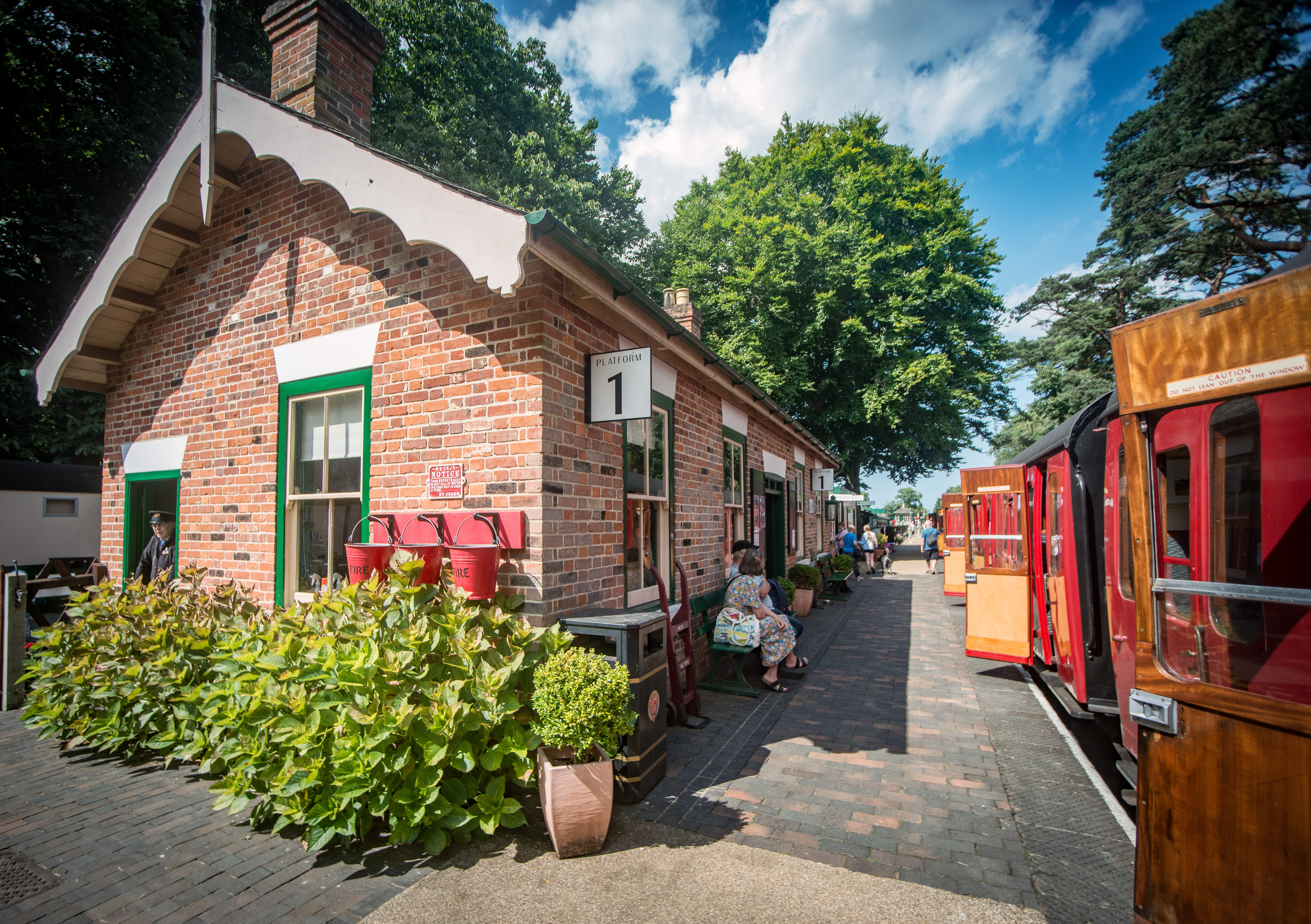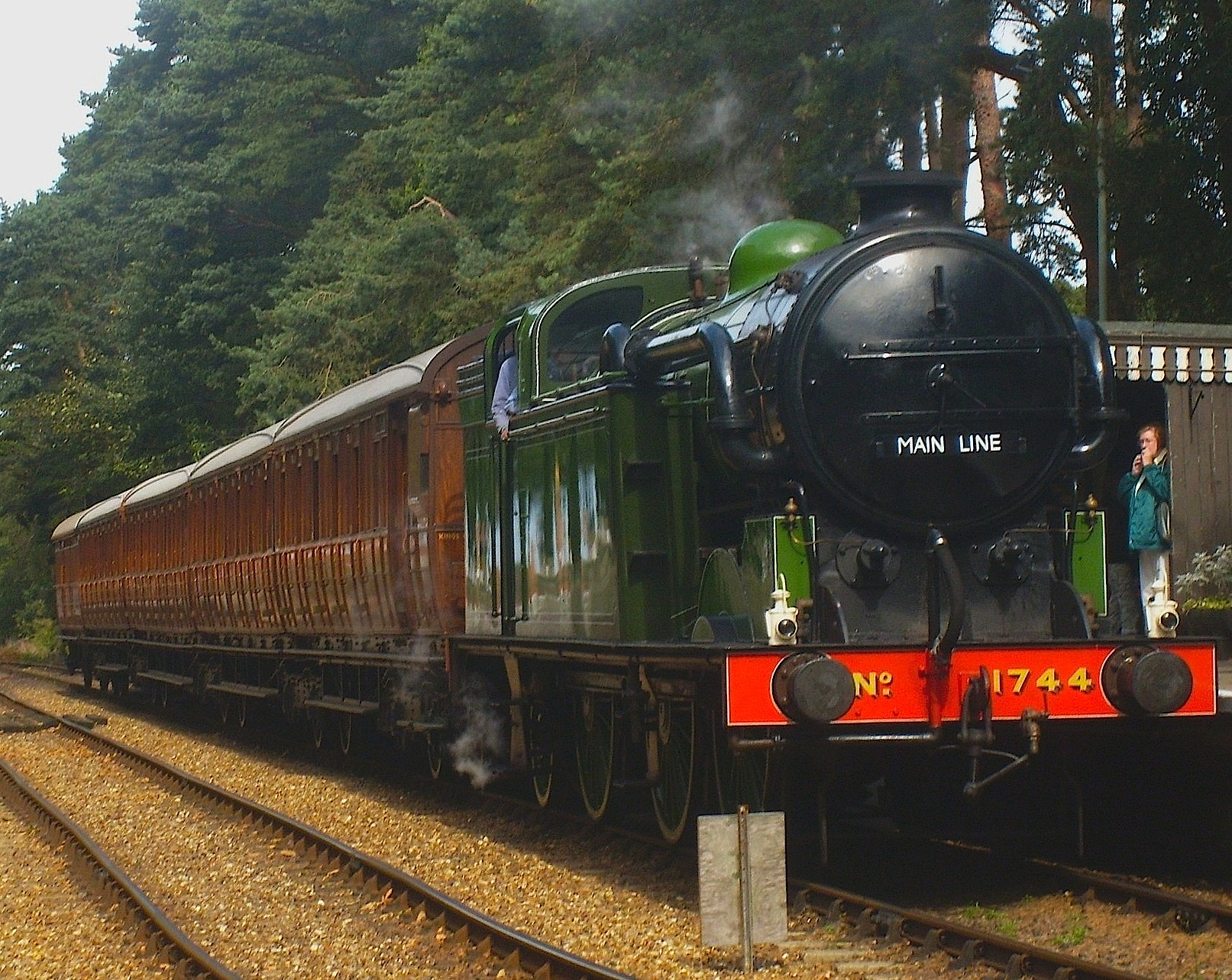|
William Marriott (engineer)
William Marriott (1857 – 17 November 1943) was the engineer, locomotive superintendent and traffic manager of the Midland & Great Northern Joint Railway (M&GN) Marriott was born at Basel, Switzerland where his father was a professor of English at the University of Basel. He was orphaned in 1868 and was brought to live in Bideford, receiving an education in England and on the continent. He served an apprenticeship with Ransomes & Rapier Ltd in Ipswich from 1875 to 1879 and as a draughtsman in 1880. He left Ransomes in 1881 to become an assistant engineer with Wilkinson & Jarvis Ltd completing a six-week unpaid trial period on the Yarmouth & North Norfolk Railway at Yarmouth. He was offered a permanent post which he accepted, and in 1883 he became the civil engineer and in 1884 the locomotive superintendent of the Eastern & Midlands Railway. This company was the amalgamation of all the Wilkinson & Jarvis lines in Norfolk, including both the Yarmouth & North Norfolk Railwa ... [...More Info...] [...Related Items...] OR: [Wikipedia] [Google] [Baidu] |
William Marriott
William Marriott may refer to: *William Marriott (engineer) (1857–1943), engineer and locomotive superintendent *William Marriott (baseball) (1893–1969), baseball player, 1917–1927 *William Marriott (magician) (ca. 1910), British magician and psychic debunker *William Thackeray Marriott (1834–1903), MP *William Hammond Marriott (1790–1851), American politician in the Maryland House of Delegates *William Marriott (cricketer) (1850–1887), English cricketer *Bill Marriott (footballer) (1880–1944), English footballer See also *Bill Marriott (born 1932), American businessman {{hndis, Marriott, William ... [...More Info...] [...Related Items...] OR: [Wikipedia] [Google] [Baidu] |
Yarmouth & North Norfolk Railway
The Eastern and Midlands Railway was formed in 1881 by the amalgamation of several small railways in the Isle of Ely, Cambridgeshire, Lincolnshire and Norfolk, England, including the Yarmouth and North Norfolk Railway, the Lynn and Fakenham Railway and the Yarmouth Union Railway. Many of these lines were built by contractors Wilkinson and Jarvis. In 1893 the Eastern and Midlands Railway became part of the Midland and Great Northern Joint Railway. Constituents The constituents of the Eastern and Midlands Railway were: * Peterborough, Wisbech and Sutton Bridge Railway, opened 1866 * Midland & Eastern Railway (incorporating Lynn and Sutton Bridge Railway, Norwich & Spalding Railway and Spalding & Bourne Railway) * Lynn & Fakenham Railway * Yarmouth & North Norfolk (Light) Railway (incorporating Great Yarmouth & Stalham Light Railway) * Yarmouth Union Railway ;Spelling variations The spellings of some place names have changed since the 19th century (e.g. Wisbeach/Wisbech and Bourn/Bo ... [...More Info...] [...Related Items...] OR: [Wikipedia] [Google] [Baidu] |
Norfolk
Norfolk () is a ceremonial and non-metropolitan county in East Anglia in England. It borders Lincolnshire to the north-west, Cambridgeshire to the west and south-west, and Suffolk to the south. Its northern and eastern boundaries are the North Sea, with The Wash to the north-west. The county town is the city of Norwich. With an area of and a population of 859,400, Norfolk is a largely rural county with a population density of 401 per square mile (155 per km2). Of the county's population, 40% live in four major built up areas: Norwich (213,000), Great Yarmouth (63,000), King's Lynn (46,000) and Thetford (25,000). The Broads is a network of rivers and lakes in the east of the county, extending south into Suffolk. The area is protected by the Broads Authority and has similar status to a national park. History The area that was to become Norfolk was settled in pre-Roman times, (there were Palaeolithic settlers as early as 950,000 years ago) with camps along the highe ... [...More Info...] [...Related Items...] OR: [Wikipedia] [Google] [Baidu] |
Long Distance Footpath
A long-distance trail (or long-distance footpath, track, way, greenway) is a longer recreational trail mainly through rural areas used for hiking, backpacking, cycling, horse riding or cross-country skiing. They exist on all continents except Antarctica. Many trails are marked on maps. Typically, a long-distance route will be at least long, but many run for several hundred miles, or longer. Many routes are waymarked and may cross public or private land and/or follow existing rights of way. Generally, the surface is not specially prepared, and the ground can be rough and uneven in areas, except in places such as converted rail tracks or popular walking routes where stone-pitching and slabs have been laid to prevent erosion. In some places, official trails will have the surface specially prepared to make the going easier. Historically Historically, and still nowadays in countries where most people move on foot or with pack animals, long-distance trails linked far awa ... [...More Info...] [...Related Items...] OR: [Wikipedia] [Google] [Baidu] |
Marriott's Way
The Marriott's Way is a long-distance footpath, cycle-path and bridleway in north Norfolk, England, between Norwich and Aylsham via Themelthorpe. It forms part of the National Cycle Network (NCN) (Route 1) and the red route of Norwich's Pedalways cycle path network. It is open to walkers, cyclists and horse riders. Its total length is 24.6 miles (39.5 km). It has a mixture of surfaces: tarmac, compacted gravel and earth. The name of the route originates from the chief engineer and manager of the Midland and Great Northern Joint Railway (M&GNJR), William Marriott, who held the position for 41 years.Marriott's Way Retrieved 21 November 2008 Railway history The path uses the trackbeds of two former railway lines: from |
Holt Railway Station (North Norfolk Railway)
Holt railway station, opened in 1987, is the current terminus of the North Norfolk Railway and is a new-build station half a mile south of the proposed, but never built, Blakeney branch junction. The station building once belonged to Stalham railway station, but was moved and reconstructed on site. The current station is located just under a mile away from the site of the original Holt railway station, which had been closed in 1964 by British Railways. William Marriott Museum The William Marriott Museum is located in the goods shed at the station. Operated by the Midland and Great Northern Joint Railway Society, the museum features railroad artefacts and memorabilia, as well as historic buildings, locomotives, rolling stock and a historic signalling system. The museum is open on days when the North Norfolk Railway is operating. Miniature railway For around 16 years, the Holt station included a miniature railway operated by the North Norfolk Model Railway Club. In 2019, t ... [...More Info...] [...Related Items...] OR: [Wikipedia] [Google] [Baidu] |
North Norfolk Railway
The North Norfolk Railway (NNR) – also known as the "Poppy Line" – is a heritage steam railway in Norfolk, England, running between the towns of Sheringham and Holt. The North Norfolk Railway is owned and operated as a public limited company, originally called Central Norfolk Enterprises Limited. The railway is listed as exempt from the UK Railways (Interoperability) Regulations 2000. History Route history The line once formed part of the Midland and Great Northern Joint Railway's Melton Constable to Cromer Beach branch line. The first section, from Melton to Holt, was opened on 1 October 1884. After a suspension of work, the Holt to Cromer section of line was completed by direct labour, and opened on 16 June 1887. A through Kings Cross to Cromer express started running in August 1887, and although the construction had been expensive, the boost to revenue from the new line was considerable. A second train was put on the following year, in the down direction cons ... [...More Info...] [...Related Items...] OR: [Wikipedia] [Google] [Baidu] |
Sheringham
Sheringham (; population 7,367) is an English seaside town within the county of Norfolk, United Kingdom.Ordnance Survey (2002). ''OS Explorer Map 252 - Norfolk Coast East''. . The motto of the town, granted in 1953 to the Sheringham Urban District Council, is ''Mare Ditat Pinusque Decorat'', Latin for "The sea enriches and the pine adorns".Town Crest and motto Retrieved 7 March 2013 History  The place-name 'Sheringham' is first attested in the
The place-name 'Sheringham' is first attested in the
|
Reinforced Concrete
Reinforced concrete (RC), also called reinforced cement concrete (RCC) and ferroconcrete, is a composite material in which concrete's relatively low ultimate tensile strength, tensile strength and ductility are compensated for by the inclusion of reinforcement having higher tensile strength or ductility. The reinforcement is usually, though not necessarily, steel bars (rebar) and is usually embedded passively in the concrete before the concrete sets. However, Prestressed_concrete#Post-tensioned_concrete, post-tensioning is also employed as a technique to reinforce the concrete. In terms of volume used annually, it is one of the most common engineering materials. In corrosion engineering terms, when designed correctly, the alkalinity of the concrete protects the steel rebar from corrosion. Description Reinforcing schemes are generally designed to resist Tension (physics), tensile Stress (mechanics), stresses in particular regions of the concrete that might cause unacceptable frac ... [...More Info...] [...Related Items...] OR: [Wikipedia] [Google] [Baidu] |
Great Northern Railway (Great Britain)
The Great Northern Railway (GNR) was a British railway company incorporated in 1846 with the object of building a line from London to York. It quickly saw that seizing control of territory was key to development, and it acquired, or took leases of, many local railways, whether actually built or not. In so doing, it overextended itself financially. Nevertheless, it succeeded in reaching into the coalfields of Nottinghamshire, Derbyshire and Yorkshire, as well as establishing dominance in Lincolnshire and north London. Bringing coal south to London was dominant, but general agricultural business, and short- and long-distance passenger traffic, were important activities too. Its fast passenger express trains captured the public imagination, and its Chief Mechanical Engineer Nigel Gresley became a celebrity. Anglo-Scottish travel on the East Coast Main Line became commercially important; the GNR controlled the line from London to Doncaster and allied itself with the North Ea ... [...More Info...] [...Related Items...] OR: [Wikipedia] [Google] [Baidu] |
Midland Railway
The Midland Railway (MR) was a railway company in the United Kingdom from 1844. The Midland was one of the largest railway companies in Britain in the early 20th century, and the largest employer in Derby, where it had its headquarters. It amalgamated with several other railways to create the London, Midland and Scottish Railway at grouping in 1922. The Midland had a large network of lines emanating from Derby, stretching to London St Pancras, Manchester, Carlisle, Birmingham, and the South West. It expanded as much through acquisitions as by building its own lines. It also operated ships from Heysham in Lancashire to Douglas and Belfast. A large amount of the Midland's infrastructure remains in use and visible, such as the Midland main line and the Settle–Carlisle line, and some of its railway hotels still bear the name '' Midland Hotel''. History Origins The Midland Railway originated from 1832 in Leicestershire / Nottinghamshire, with the purpose of serving the ne ... [...More Info...] [...Related Items...] OR: [Wikipedia] [Google] [Baidu] |
Lynn & Fakenham Railway
The Eastern and Midlands Railway was formed in 1881 by the amalgamation of several small railways in the Isle of Ely, Cambridgeshire, Lincolnshire and Norfolk, England, including the Yarmouth and North Norfolk Railway, the Lynn and Fakenham Railway and the Yarmouth Union Railway. Many of these lines were built by contractors Wilkinson and Jarvis. In 1893 the Eastern and Midlands Railway became part of the Midland and Great Northern Joint Railway. Constituents The constituents of the Eastern and Midlands Railway were: * Peterborough, Wisbech and Sutton Bridge Railway, opened 1866 * Midland & Eastern Railway (incorporating Lynn and Sutton Bridge Railway, Norwich & Spalding Railway and Spalding & Bourne Railway) * Lynn & Fakenham Railway * Yarmouth & North Norfolk (Light) Railway (incorporating Great Yarmouth & Stalham Light Railway) * Yarmouth Union Railway ;Spelling variations The spellings of some place names have changed since the 19th century (e.g. Wisbeach/Wisbech and Bourn/Bo ... [...More Info...] [...Related Items...] OR: [Wikipedia] [Google] [Baidu] |





